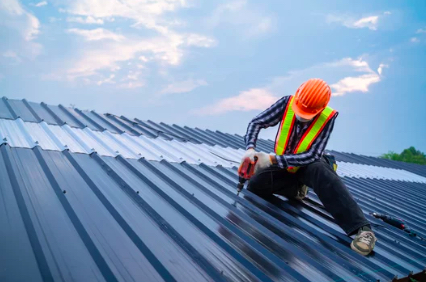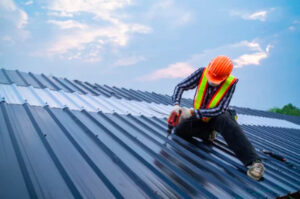Roof Repair can be a daunting home improvement project. It’s generally best to leave major repairs and installation to a professional roofer to avoid violating any material warranties.
Re-roofing can be expensive because it requires a large amount of time, labor, and materials. It also cannot address underlying problems such as leaks, ice dams, and condensation.
Shingles are a crucial part of your roof, and keeping them in good condition is one of the most important things you can do to keep water from seeping through and damaging your home. If a shingle is damaged by a strong storm or by age, it needs to be replaced right away or the damage may worsen.
Replacing a single damaged shingle is not complicated, but you must have a ladder and safety precautions in place before climbing up on your roof. The best tool to have is a flat pry bar, which you can slide underneath the row of shingles directly above the damaged area. This will separate the shingles and release the adhesive sealer strip, which you can then remove with a claw hammer.
If the shingle is just cracked, you don’t need to replace it; instead, use a caulking gun to apply a thick bead of roofing sealant under the crack and weigh it down with a brick. Then, spread a second bead of sealant on top of the crack and smooth it with a putty knife. Finally, collect a few shingle granules from the gutter and sprinkle them over the sealant to camouflage the repair.
When replacing a damaged shingle, it’s important to match the color and style of the other shingles around it. This will help to prevent a patchwork effect, which looks unattractive and can contribute to the development of leaks.
It’s also a good idea to check for areas where the caulking has failed or shrunk, such as along the flashing around chimneys and vents, or any places where the metal has corroded. Regular maintenance such as clearing cobwebs, re-caulking and re-nailing areas of the roof and gutters can prevent costly problems down the road.
If you aren’t comfortable performing these repairs yourself, MARS Restoration can take care of it for you. Just call us today and we’ll set up an appointment. We have a team of professional roofers ready to get started! Our experienced professionals are here to provide the quality of work you can trust.
Flashing
In addition to the roofing material, it’s important to have expertly installed flashing to protect a home from water damage. Flashing is a thin sheet of metal, typically made from copper or aluminum, used to seal and protect vulnerable areas of a roof like seams, valleys, and penetrations. Roofers install it along the edges of roofs, where roofs change slope, around chimneys and vent pipes, skylights, and more.
It’s also embedded in wall interruptions such as windows and doors, to prevent water ingress or to direct water that has entered back outside. There are several different types of flashing, including:
A common type of flashing is flat or base flashing, a sheet of metal that lies at the bottom of a junction and is covered with shingles. A more durable flashing option is step flashing, which consists of rectangles of sheet metal bent into an “L” shape and stacked on top of each other, much like fish scales. The L-shaped flashing is then nailed to the roof, with the top of the flashing secured with shingle cement or roof caulking.
Flashing materials must pass another test: they need to expand and contract along with a roof’s surface as temperatures rise and fall. When properly installed, metal flashing is designed to do this without leaking. However, if it becomes loose or damaged, it can leak through the gap and cause interior damage.
Some of the signs that flashing is failing include visible cracks or rust spots, leaking at joints and valleys, or water stains on interior walls or ceilings. It’s a good idea to have a professional inspect your roof on an annual basis, especially if you live in an area that experiences harsh weather conditions. A trusted roofing contractor will inspect your flashing for signs of damage, as well as other components of your roof such as scuppers, gutters, and more.
Gutters
Guttering is an integral part of any roof system. It allows rainfall to quickly make its way from where it falls – on your roof – to where it needs to go – away from your home. Gutters also protect the fascia, soffit and other parts of your roof from water damage and help reduce moisture that causes mold and mildew in soffits and wood fascia boards.
There are many types of gutters available, but the most common on homes today are 5-inch, K-style gutters made from aluminum. They are sold in 10-foot lengths and easily connect at corners with gutter connectors. These gutters can be used in place of old gutters or as a replacement for older gutters that have become clogged with leaves and debris.
Homeowners may try to replace their own gutters but it is best left to a professional for safety and proper installation. Incorrectly installed gutters can interfere with the slope of a roof and cause it to sag or leak. Gutters must be properly anchored to the fascia board and secured at the end with downspout hangers or brackets.
A gutter’s most basic function is to collect rainwater and channel it from the roof through downspouts to the ground, avoiding pooling around the foundation of the house. Without working gutters, water that pools over the edges of your roof can erode the ground and soffits, and damage the paint and stain on siding and trim.
Gutters are an inexpensive investment that prevent expensive problems down the road. Gutters and downspouts must be kept clear of clogs to work properly. If you have gutters that are constantly clogged, call your roof repair expert for help.
When you need a new roof or gutters, it’s important to choose a roofing contractor that is licensed and insured. In addition, you want a roofer who has years of experience and is familiar with the local weather conditions in your area. A skilled and reliable roofer should be able to provide you with a free estimate on the cost of your project.
Soffit
The soffit is a piece of trim that covers the underside of the roof overhang. It serves a dual purpose: it adds to the beauty of your home or commercial structure and protects the rafters from harsh weather elements. Without a properly functioning and attractive soffit, your rafters would be exposed to the sun, rain, snow, and other outdoor elements. This can lead to rot, mold buildup, and ultimately, expensive repairs.
A soffit is often made from wood, but it can also be made from aluminum, vinyl, or fiber cement. It can be custom-cut to fit the shape of your home, or it can come pre-cut from the store. Whether your soffit is wood or other material, it needs to be resealed on a regular basis to keep water out. It should also be checked for signs of rot and replaced if needed.
If your soffit and fascia are damaged, it is important to contact a roofing professional as soon as possible for repairs. Not only will they help with repairing these pieces of trim, but they can also inspect the rest of your roof to make sure there are no other issues that need to be addressed.
Your attic needs ventilation in order to maintain a healthy environment, and your soffit is an essential part of this system. A soffit allows air to enter and release heat in the summer and keeps cold air flowing into your attic in winter to prevent large, damaging ice dams from forming on your roof.
Fascia and soffit can be painted to match the color of your house, or they can be stained or painted for a more natural look. They can be found in a variety of colors, although white is the most common. If you choose to stain or paint your soffit, it is important that you use a high-quality stain or paint.
Soffits and fascia can be damaged by rot, mold, and pests. A good way to test for mold is to tap the soffit with a screwdriver. If pieces of the soffit immediately fall off, it is time for a repair.


